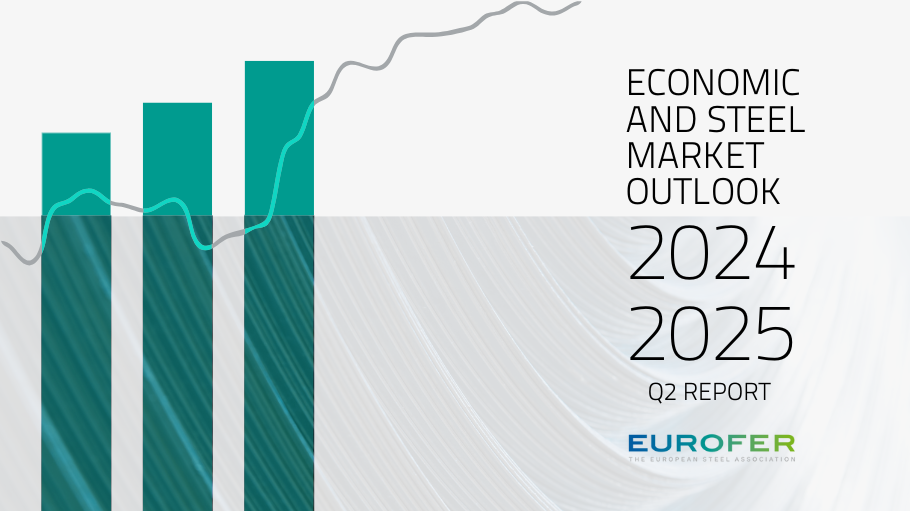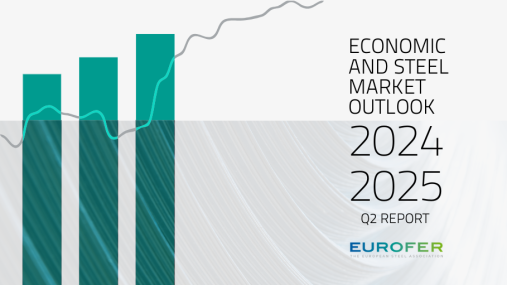
Publications » Economic and market outlook » Economic and steel market outlook 2024-2025, second quarter
Economic and steel market outlook 2024-2025, second quarter
Downloads and links
Recent updates

The negative trend in the steel market observed in the first half of 2023 has shown persistence while getting more acute over the last two quarters. Although the severe consequences of the war in Ukraine and the deteriorating overall economic outlook continued to take their toll, apparent steel consumption in the EU increased (+2.8%) in the fourth quarter of 2023, mainly due to the comparison with the very low volumes seen one year earlier. After a significant recession (-8.3%) in 2022, persistent downside factors such as ongoing conflicts, uncertainty surrounding energy prices and inflation combined with a worsened economic outlook, have negatively impacted apparent steel consumption in 2023 even further. The data reveal a more pronounced contraction (-9%) compared to the previous outlook (-6.3%), marking the fourth annual recession in the last five years.
This downward trend is set to weigh also on the rebound which was anticipated for this year. In 2024, conditional on more favourable developments in the industrial outlook and increased steel demand, apparent steel consumption is projected to recover at a lower rate than previously estimated (+3.2%, formerly +5.6%). The overall evolution of steel demand remains subject to very high uncertainty. Quarterly improvements in apparent steel consumption are expected to continue throughout 2024, albeit resulting in volumes still below pre-pandemic levels.
In the third quarter of 2023, apparent steel consumption dropped for the sixth consecutive quarter (-3.9%), after -8% in the preceding quarter). The total volume decreased to 30.4 million tonnes, marking the third lowest level since the outbreak of the pandemic in the second quarter of 2020.The current downturn in EU apparent steel consumption began in the second quarter of 2022, due to war-related disruptions, unprecedented rises in energy prices and production costs. Demand conditions have been worsening considerably since the second half of 2022, and this negative cycle is expected to persist at least until the fourth quarter of 2023, as a result of growing global economic uncertainty, high interest rates and overall manufacturing weakness.
Domestic deliveries continued to mirror weak demand and decreased (-2.9%) for the sixth consecutive time in the third quarter of 2023, although at a less pronounced pace than in the second quarter (-7.1%). In 2021, deliveries had rebounded significantly (+11.9%), after the sharp drop in 2020 (-9.6%) and the already negative performance in 2019 (-4.2%). As a result of the unfavourable developments in the last two quarters of the year, in 2022 domestic deliveries markedly dropped (-9.1%).
Imports into the EU including semi-finished products remained unchanged in the third quarter of 2023, after the decrease seen in the preceding quarter (-10.2%). However, it is worth noting that the drops in imports recorded in preceding quarters are essentially a reflection of weak demand conditions. Therefore, the share of imports out of apparent consumption has remained considerably high in historical terms, even in the third quarter of 2023 (27%).
In the third quarter of 2023, for the first time the Steel Weighted Industrial Production index (SWIP) went to negative territory (-0.3%), after a meagre increase (+0.4%) in the second quarter of 2023. Until then, EU steel-using sector’s output had continued to grow, showing unexpected resilience despite the protracted impact of Russia’s invasion of Ukraine, overall manufacturing weakness and global geopolitical tensions along with above-average energy prices.
The latest developments of the SWIP index were a combination of a continued downturn in the construction, mechanical engineering, domestic appliances and metalware sectors, only partly compensated by the continued growth in the automotive. The construction sector entered recession in the third quarter of 2022 and saw its fifth consecutive quarterly drop (-1.2%, after -3.4%) in the third quarter of 2023. Its recessionary trend is expected to continue. The positive trend in SWIP, started after the pandemic, continued until the second quarter of 2023 in spite of soaring energy prices impacting production costs, component shortages and lower output that took their toll on total production activity in steel-using sectors in the second half of 2022.
The deterioration of the economic and industrial outlook in the EU – particularly due to high inflation and the subsequent interest rate hike by the European Central Bank (ECB) – has had a limited impact on steel-using sectors’ output so far. The construction sector, which accounts for 35% of steel consumption in the EU, was the only significant exception.
The ongoing economic uncertainty is set to continue affecting the steel market growth over the upcoming quarters:
1. Despite EU industry having proven quite resilient up to the second quarter of 2023, the remainder of 2023 appears to be characterised by a worsening combination of uncertainties in energy prices, weak demand, inflation, geopolitical tensions and economic challenges driven by high interest rates.
2. While output grew more than expected (+3%) in 2022, SWIP growth for 2023 is forecasted to slow down (+0.7%, slightly less than previously estimated, +0.6%), albeit with wide differences among individual EU economies and industrial sectors.
3. In 2024, steel-using sectors’ growth is projected to further decelerate (+0.2%, revised downwards from +0.4%), mainly due to the second recession in a row in the construction sector, before picking up moderately (+1.5%) in 2025.

Download this publication or visit associated links
Brussels, 02 December 2025 – Unchanged negative conditions – U.S. tariffs and trade disruptions, economic and geopolitical tensions, protracted weak demand and still high energy prices – continue to weigh on the European steel market. EUROFER’s latest Economic and Steel Market Outlook confirms for 2025 another recession in both apparent steel consumption (-0.2%, unchanged) and steel-using sectors (-0.5%, revised from -0.7%). A potential recovery is expected only in 2026 for the Steel Weighted Industrial Production index (SWIP) (+1.8%, stable) and for apparent steel consumption (+3%, slightly revised from +3.1%) – although consumption volumes would still remain well below pre-pandemic levels. Steel imports retained historically high shares (27%), while exports plummeted (-9%) in the first eight months of 2025.
Fourth quarter 2025 report. Data up to, and including, second quarter 2025
Brussels, 27 November 2025 - The European ceramic, aluminium, ferro-alloys and steel industries express their deep concern about the potential impact of the EU-India FTA on strategic European industries if a sector-specific approach is not adopted and our sectors’ challenges are not duly considered.